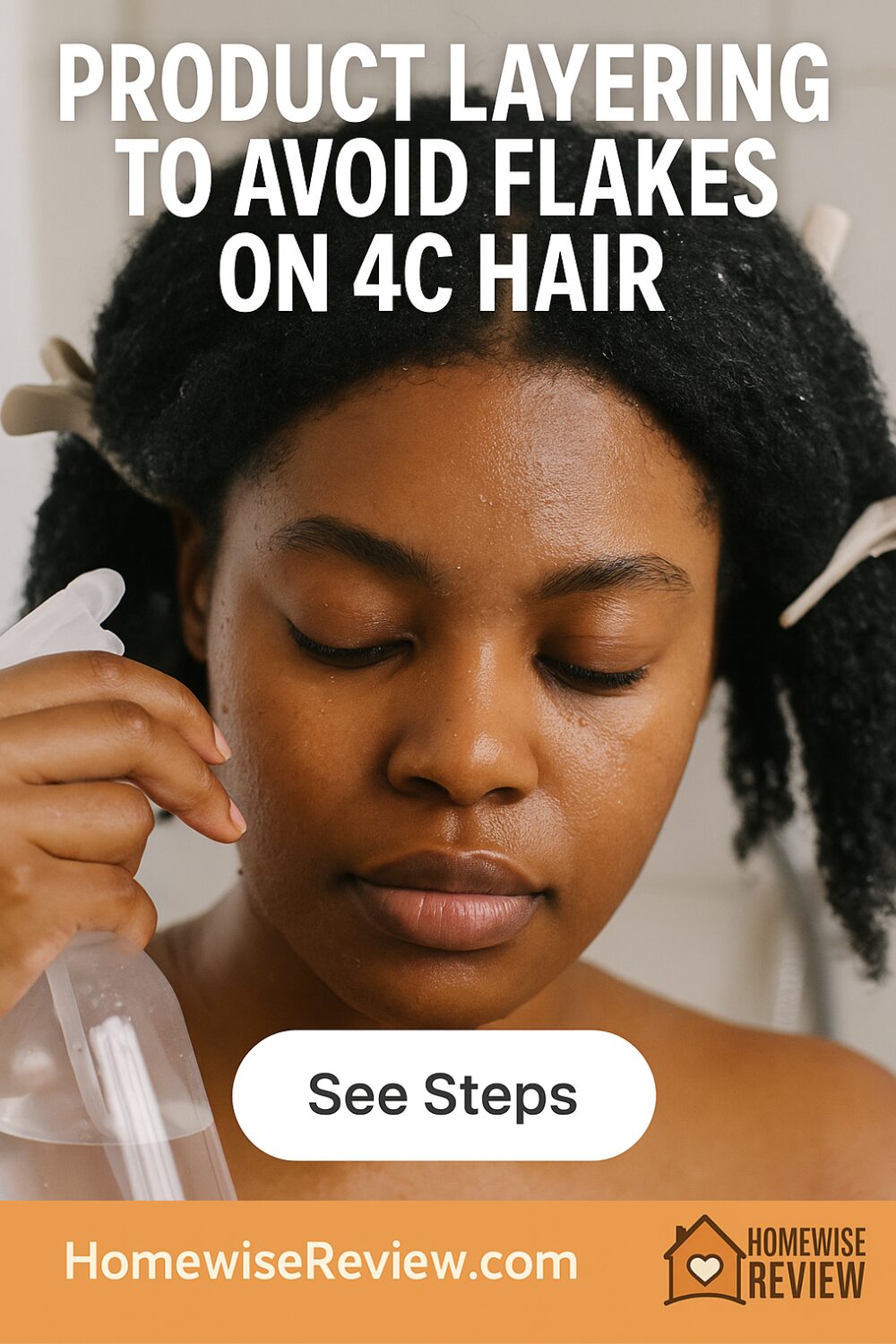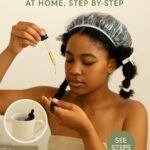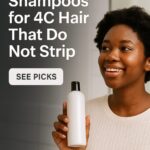
Flakes usually come from three things: too much product, incompatible formulas fighting each other, or applying to hair that is not wet enough. 4C hair loves slip first with hold on top, plus thin layers that have time to settle. Use the playbook below to keep definition high and flake risk low.
Why products flake on 4C hair
- Polymer clashes: Gels and creams from different lines can ball up when their thickeners or fixatives do not mix well.
- Layer overload: Heavy leave-in plus rich cream plus strong gel often dries into crumbs.
- Water level: Applying hold on damp-not-wet hair creates drag lines that dry into flakes.
- Oil first: Oils under gel block water and stop polymers from forming a smooth film.
The golden order that works most of the time
- Water: hair should be soaking wet for wash-and-go or very damp for twist or braid sets.
- Leave-in: light, slip-forward.
- Cream: only if you truly need extra moisture. Thin layer.
- Foam or gel: your main hold. Pick one lead actor.
- Oil/serum: optional and last, on ends only.
Owner feedback and stylist commentary agree this order prevents most pilling. If in doubt, skip the cream and go leave-in straight to hold.
Quick comparison: layering by style goal
| Goal | Order (thin layers) | Key tip | Avoid |
|---|---|---|---|
| Wash-and-Go definition | Water → Leave-in → Gel | Rake on soaking-wet hair, then glaze more gel on the surface | Cream under strong gel unless hair is very dry |
| Twist/Braid set with soft hold | Water → Leave-in → Foam → Tiny oil on ends | Foam smooths and dries faster with less residue | Heavy creams that slow dry time |
| Stretch with moisture all week | Water → Leave-in → Cream → Light gel glaze | Use nickel-size cream per quadrant max | Oil before gel or too much cream |
| Humid day control | Water → Leave-in → Gel → Micro-serum on ends | Choose a humidity-resistant gel and hands-off until fully dry | Touching hair while drying |
Ratings reflect a summary of owner feedback and stylist commentary.
Step by step: flake-free application
- Load water first
Work in 4–8 sections. For wash-and-go, keep a spray bottle handy and re-wet each section until curls feel saturated. - Slip layer
Smooth a light leave-in from ends up. Detangle gently so strands lie parallel. - Decide cream or no cream
If your hair is high porosity or feels rough, add a pea to dime of cream per section. If you clog easily or live in humidity, skip cream. - Palm test for compatibility
Mix a pea of leave-in with a pea of your gel or foam in your palm. If it turns milky and smooth, you are good. If it curdles or pills, swap one product. - Apply hold correctly
- Gel: rake through soaking-wet hair, then glaze a little more gel over the top without disturbing clumps.
- Foam: pump into your hand and smooth down the section, then twist or braid.
Keep layers thin so air can reach the roots.
- Hands off while drying
Air dry or sit under a hooded dryer. Do not separate or pick until fully dry. Scrunch out any cast with a drop of serum once dry. - Seal ends only
If your ends look thirsty, tap a few drops of oil on the last inch. Oil goes last so it does not block water.
Amount guide that actually helps
- Leave-in: nickel per quadrant of your head.
- Cream: pea to dime per section, only if needed.
- Gel: quarter per section for wash-and-go, less for sets.
- Foam: 1–2 pumps per medium section.
If you see product sitting white on the surface, you are using too much or your hair is not wet enough.
Porosity tweaks
- Low porosity
Use warm water, the lightest leave-in you can, and go straight to gel or foam. Keep layers whisper thin. Clarify monthly to prevent buildup that causes faux flakes. - High porosity
A little cream before gel can prevent dryness. Still keep it minimal and focus cream on mid-lengths to ends. Finish with a cool dryer setting to help the film set.
Match the climate
- High humidity: pick a humidity-resistant gel and skip heavy creams. Dry completely under a hooded dryer so the gel film sets.
- Dry winter air: layer a touch of cream under gel or choose a cream-gel hybrid. Seal ends lightly once fully dry.
Refresh rules that do not create crumbs
- Day 2–3: lightly mist with water or a liquid leave-in. Smooth a pump of foam over frizzy sections. Clip roots to set while it dries.
- Do not rub more gel over old gel unless you fully re-wet the section first. Gel on top of a set film is a flake trap.
Troubleshooting
- White specks right away: incompatible products. Redo the palm test and switch either the leave-in or the gel to a formula from the same brand family.
- Dusty flakes on day two: too much product or hair was not fully dry. Use less next time and dry under a hooded dryer until cool to the touch.
- Sticky feel: swap a cream for foam, or reduce glycerin-heavy products in high humidity.
- Roots puffy, ends crunchy: sections were too big. Work smaller at the roots, then glaze product on the surface for even film formation.
- Edge control pilling: apply edges last with a clean brush. Edge waxes often fight with gels when layered early.
Final Thoughts
Flake-free results come from thin, compatible layers on very wet hair and zero touching until dry. Keep leave-in light, make cream optional, choose one lead hold, and seal ends last. Do a quick palm test before you commit, then let heat or air set the film completely. With that rhythm, your 4C styles stay clean, defined, and comfortable all week.
See Also
If your gel is the wild card, start with our No Flake Styling Gels for 4C Wash and Go and pair a pick with the Wash and Go on 4C Hair Realistic Method so your application matches the formula. Clean hair makes layering easier too, so rotate in Best Shampoos for 4C Hair That Do Not Strip when you need a fresh slate.
When your routine needs a gentler cleanse, switch to one from Sulfate Free Shampoos for Natural Hair That Actually Clean and detangle with tools from Best Brushes for 4C Hair Detangling and Stretching to keep definition intact before you ever touch gel.
FAQs
Should cream go before or after gel
Before, and only if needed. Many 4C routines skip cream and go leave-in straight to gel to avoid clumping and flakes.
Foam or gel for less flaking
Foam is forgiving on twist or braid sets. For wash-and-go definition, gel wins if you apply on soaking-wet hair and keep layers thin.
Why do I still get flakes with one brand system
Too much product or not letting it dry fully. Reduce amounts by a third and set under a hooded dryer.
Can I use oil under gel
Skip it. Oil first blocks water and causes the gel film to break. Use oil last on ends only.
How do I fix flakes without rewashing
Mist sections well, add a pump of foam, and smooth. Once dry, gently shake out the residue. If flakes persist, clarify and start fresh.




